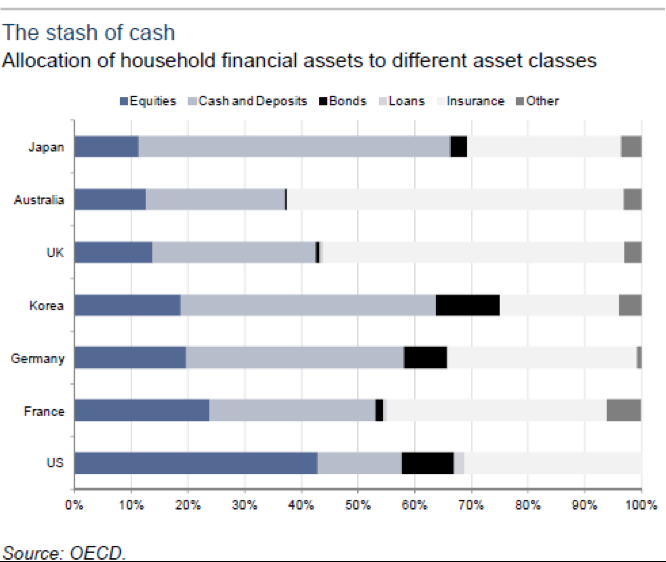The myth of the bond market bubble
Post on: 18 Август, 2015 No Comment

By rogermcintosh on 24 March 2013
Since the sharemarket collapse in 2008 we have seen interest rates fall to levels hitherto not seen since the first half of the 20th century. This has had a significant impact on the return of bonds as an asset class, with above average returns from rising bond prices associated with the decline in yields. I have seen many articles and heard many investors suggest that the bond market is in a bubble state which could unravel is yields were to rise rapidly. It is important that investors don’t associate the significantly negative returns that can arise from a bursting equity market bubble to the bond market returns that come from rising interest rates.
- The concept of a bubble suggests that assets are trading at prices some market participants consider overvalued. Clearly there is a natural ceiling on the price of a bond, albeit a logical extreme that doesnt reflect the time value of money the sum of the remaining coupons and return of principal. More importantly, the pull to par nature of bonds, where the market value of a bond coverges to its face value at maturity acts as an anchor on bond prices.
- Bonds and bond index dynamics behave differently to equity markets and indexes it is incorrect to impute the paradigm of an overheating equity market bubble to onto the bond market. Bond market returns are characteristically different to equities over similar timesframes and are more narrowly distributed, even during periods of rising yields. For sure, a rise in yields will cause short term negative returns as the capital changes are greater than coupon payments. Over the longer term
- The role of bonds is to provide income, captial stability and a source of diversification to growth asset classes. These characteristics have not changed, even at yields lower than what has been experienced over the last 20-30 years. The long run return from a broadly diversified portfolio of bonds should reflect the average level of interest rates through time. With the current low level of bond yields, this suggests that returns for bonds will be lower than average for some time.
Bond market dynamics are different to equities and bonds react differently to a rise in yields depending on the nature of the bonds. Longer term bonds will have a greater percentage change than shorter term bonds. The change in bond prices associated with the rise in yields is different to what has been historically observed with price collapses associated with bursting equity market bubbles.
The chart shows two different regimes for monthly returns of the ASX300 Index and the UBS Australia Composite Bond Index during the period December 1992 to December 2012. The chart on the left shows the box-and-whiskers distribution plot of the worst 10% of equity market monthly returns and the associated bond market returns for those months. It shows that during these regime of negative equity market return, the returns for bonds were typically positive, with more than 75% of the observations greater than zero. This demonstrates the downside protection and diversification effect of a portfolio of bonds during these events, which is typically a flight-to-safety effect.
The chart on the right shows the distribution of the worst 10% of monthly bond market returns. This typically has not been studied in significant detail in the media reports, merel that if yields rise rapidly therell be negative returns. When we observe what has occurred, the story is not as dramatic. For sure, we observe negative returns, with the worst return being around -3% for one month in August 1992. The majority of the worst observed returns were in a very narrow range, but were certainly not significantly large negative values. Even though returns were negative, but small, there is still downside protection during these regimes of rising yields. Interestingly though, half of the equity market returns during regime were positive as the rising yields tended to be associated with expanding economic conditions.
The primary contributor to bond market returns is coupon income, which reflects the overall level of interest rates and the degree of credit risk associated with the bond issuers. Unless a bond issuer defaults, which is unlikely for investment grade bonds, it is not possible for bonds to be subject to a “bubble” environment. The nature of their returns, driven by the coupon income and the return of the bond to its face value at maturity, means there is an upper limit on the value of the bond. For the UBS Composite Index, over the long term, coupon income accounts for almost 90 per cent of the annualised return.
This second chart shows Australian government 3 and 10 year bond yields (on the left axis) versus the accumulated value of the UBS Australia Composite Bond Index (on the right axis). It demonstrates how broad bond maket returns and the portfolio value trajectory have remained robust regardless of yield volatility and direction.
Although there may be short term negative returns when yield increases mean the change in the value of bonds is greater than the coupon income, this washes through over time as newer bonds are typically issued at higher yields. If anything, rising interest rates should be good for investors. The most important objective for any bond portfolio is to mitigate default risk, which can cause real and permanent negative returns. Thus, the best strategy for bond investing in any market conditions is broad diversification.














